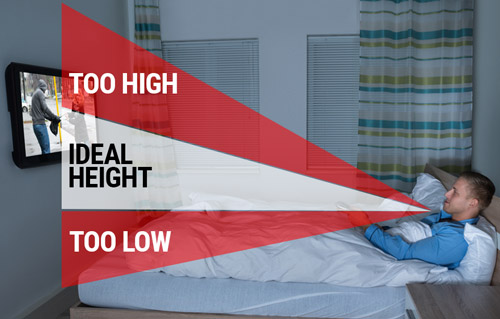If you’ve ever craned your neck to binge a show in bed, you know the pain. As a home media consultant who has mounted hundreds of bedroom TVs, here’s the simple truth: the best height is where the center of the screen lines up with your eye level in your actual viewing position. In most bedrooms, that means mounting a bit higher than living rooms and using a slight tilt. This guide breaks down how high to hang tv in bedroom with clear rules, easy math, and pro tips you can trust. Read on to get it right the first time.

Source: www.reddit.com
The Quick Answer
Most bedrooms feel best when the center of the TV is 36 to 48 inches from the floor if you watch while propped up on pillows. If you like the TV higher on the wall, use a tilt mount (10 to 15 degrees) and keep the center of the screen within 0 to 12 inches above your eye level. Avoid going higher than 20 inches above eye level unless you must.
Fast rules I use in real projects:
- If you sit upright on the bed: aim for a TV center around 42 inches from the floor.
- If you recline with two pillows: TV center 38 to 44 inches, with 5 to 10 degrees tilt.
- If you watch mostly lying back: mount higher, but add 10 to 15 degrees tilt and keep the center within 6 to 12 inches above eye level.

Source: metrahometheater.com
The Ideal Viewing Height Formula
Start with your eye level from the floor in your usual viewing posture. The ideal TV center height equals your eye level. Use tilt to allow a higher mount while keeping your neck relaxed.
Simple steps:
- Sit or recline as you normally watch. Have someone measure from floor to the center of your pupils. That is EyeLevel.
- Ideal Center Height = EyeLevel.
- Add tilt if you prefer a higher mount.
- With 0 to 5 degrees tilt: keep center within plus or minus 6 inches of EyeLevel.
- With 10 degrees tilt: center can be 6 to 12 inches above EyeLevel.
- With 15 degrees tilt: center can be 10 to 20 inches above EyeLevel.
Why this works:
- Ergonomic guidelines show that a slight downward gaze reduces neck strain.
- Tilting the screen aims the picture at your eyes, which keeps colors and brightness uniform on modern LED and OLED panels.
Quick example:
- Your EyeLevel while reclining is 40 inches. You prefer a higher mount for decor. Use 10 degrees tilt and set the TV center at 48 inches.

Source: tvwallmounting.ca
Measure Your Bedroom And Bed
Bedroom setups vary a lot. Measure before you drill.
What to measure:
- Bed height: floor to top of mattress. Many beds are 22 to 30 inches.
- Eye level: on your pillows in your normal viewing position.
- Viewing distance: eyes to screen. Common range is 7 to 10 feet.
- TV size and VESA pattern: needed to place the wall plate and compute center height.
Size and distance tips:
- 43 to 55 inches: 6 to 9 feet away feels great.
- 65 inches: 8 to 10 feet away.
- Larger screens allow a slightly higher mount without feeling “too high,” but still use tilt above eye level.
Decorator note from the field:
- Nightstands, headboard height, and art all push people to mount higher. That is fine if you add proper tilt and keep the center within 12 inches of your eye level.
Choose The Right Mount And Tilt
The mount decides how forgiving your height can be.
Mount types:
- Fixed mount: best when the TV center can sit right at eye level. Clean look, low profile.
- Tilt mount: best for bedrooms. Aim for 5 to 15 degrees tilt when the TV sits higher than eye level.
- Full-motion mount: useful in odd rooms or corner installs. Pull forward to reduce glare and align with your eyes.
Practical advice:
- For any mount above eye level, I almost always choose tilt. It’s the easiest way to stay comfortable and reduce neck strain.
- Choose a mount rated well above your TV’s weight. Check VESA compatibility.
- Pick a mount with a built-in level and post-install micro-adjustments. It saves headaches.
Safety, Studs, And Cable Tips
A safe install matters more than any rule of thumb.
Studs and anchors:
- Always mount into wood studs or solid masonry. Use a stud finder and confirm with a small test drill.
- Use the supplied lag bolts or stronger. Do not rely on plastic anchors for large TVs.
Cables and power:
- Plan cable paths before you mount. Use an in-wall rated power kit or a code-compliant outlet behind the TV.
- Route HDMI and power on separate sides of the mount to avoid pinch points.
- For clean looks, add a brush plate and short certified HDMI cables.
Load and spacing:
- Keep at least 2 to 3 inches clearance above and around the TV for cooling and cable bends.
- For chests or dressers under the TV, leave 6 to 10 inches gap from the top surface to the TV bottom edge to avoid knocks and vibrations.
Common Mistakes To Avoid
From years in the field, these cause most problems:
– Mounting by guesswork. Measure eye level first.
– Hanging too high without tilt. Even premium panels feel washed out when angled wrong.
– Ignoring glare. Check windows and overhead lights at your watch time.
– Using weak anchors. Heavy sets need studs or masonry.
– Cable slack too short. Leave gentle loops to avoid strain when tilting or pulling.
Step-By-Step Mounting Checklist
Follow this quick checklist for a smooth install:
– Sit or recline as you watch. Measure EyeLevel.
– Decide center height using EyeLevel and your planned tilt.
– Mark the wall centerline of the TV at that height.
– Find studs. Mark two studs within the mount’s width.
– Hold the wall plate on the marks. Level it. Drill pilot holes.
– Lag-bolt the plate into studs. Re-check level.
– Attach brackets to TV using the right VESA screws and spacers.
– Connect power, HDMI, and streaming devices while TV is still on a soft surface.
– Hang the TV on the plate. Set tilt to 5 to 15 degrees as needed.
– Sit back in bed. Fine-tune tilt and micro-adjust until the image feels natural.
Real-Life Scenarios And Pro Tips
Small room, 43-inch TV over a dresser:
– EyeLevel reclining: 38 inches. Use 10 degrees tilt.
– Set TV center at 46 inches. Bottom clears the dresser by 8 inches. Looks neat and feels easy on the neck.
Large room, 65-inch opposite a tall headboard:
- EyeLevel: 42 inches. You want the TV higher for symmetry.
- Use 12 to 15 degrees tilt.
- Set TV center at 54 to 58 inches. The bigger screen size makes this feel natural.
Kids or guest room:
- Keep it simple and safe. Lower mounts with minimal tilt work best.
- Use cord covers or in-wall kits to keep cables out of reach.
Lessons learned:
- Test with painter’s tape. Mark the outline of the TV and the proposed center height. Lie down and see how it feels before drilling.
- If two people watch, average your eye levels, or bias toward the person who watches more.
Eye Comfort And Health
Comfort is not only about height. It is also about angles and light.
Pro comfort tips backed by ergonomic best practices:
- Aim for a slight downward gaze to reduce neck flexion.
- Keep the top third of the screen near eye level when using small tilt angles.
- Reduce glare with blackout curtains or angled lighting.
- Use Warm or Filmmaker Mode at night to soften blue light.
- Keep brightness modest in dark rooms to reduce eye fatigue.
If your neck feels tight after a week:
- Lower the center by 2 to 3 inches or increase tilt by 2 to 3 degrees.
- Pull a full-motion mount a few inches forward to reduce the vertical angle.
Frequently Asked Questions Of How High To Hang Tv In Bedroom
Q. What Is The Best Height For A Bedroom TV?
The best height puts the TV center at your eye level in your normal viewing position. In bedrooms, that is usually 36 to 48 inches from the floor, plus 5 to 15 degrees tilt if the TV is mounted higher.
Q. Should I Use A Tilt Mount In The Bedroom?
Yes, in most cases. A tilt mount lets you place the TV a bit higher without neck strain. Aim for 5 to 15 degrees tilt when the center is above your eye level.
Q. How Do I Measure Eye Level Accurately?
Sit or recline as you usually watch. Have someone measure from the floor to the center of your pupils. Use that number as your target TV center height.
Q. Does TV Size Change The Mounting Height?
It changes how high feels comfortable. Larger screens can sit a bit higher without feeling strained, but still keep the center within about 12 inches of your eye level if you add tilt.
Q. What If I Have A Dresser Under The TV?
Leave 6 to 10 inches between the top of the dresser and the bottom of the TV. Then set the TV center based on your eye level and tilt. This keeps it safe and easy to view.
Q. Can I Mount A TV On Drywall Without Studs?
Not recommended for heavier TVs. Use wood studs or masonry. If studs are off-center, use a wider wall plate or a mounting rail designed to span studs.
Q. How Do I Reduce Glare In A Bright Bedroom?
Use blackout or light-filtering shades, angle lamps away from the screen, and add a slight tilt. A matte screen finish also helps.
Conclusion
Getting bedroom TV height right is simple when you start with your eye level and add tilt as needed. Measure your real viewing posture, set the TV center to match, and fine-tune with 5 to 15 degrees tilt for comfort. Avoid guesswork, plan cables, and mount into studs for long-term safety.
Try the painter’s tape test tonight. Mark your target height, lie down, and see how it feels. When it looks and feels right, you are ready to mount with confidence. Want more tips like this? Subscribe, leave a comment with your room size and TV model, or explore our other home setup guides.
